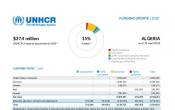Algeria
Operation: Algeria
Location
{"longitude":3,"latitude":27,"zoom_level":5,"iso_codes":"'DZA'"}
By clicking on the icons on the map, additional information is displayed.
The boundaries and names shown and the designations used on this map do not imply official endorsement or acceptance by the United Nations.
Key Figures
| 2020 planning figures | |
| 100% | of primary school-aged Sahrawi refugee children will be enrolled in primary education |
| 1,005 | shelter maintenance tool kits and materials will be provided to Sahrawi refugees |
| 250 | refugees and asylum seekers living in urban areas and with psycho-social needs will receive psychosocial support |
| 20 | litres of potable water will be available on average per person, per day |
| 15 | health facilities will be constructed or rehabilitated and equipped with medical supplies |
| 1 | mechanism for the referral of asylum-seekers will be established |
| 2018 year-end results | |
| 100% | of primary school-aged Sahrawi children had access to education, with 38,512 children enrolled in school |
| 100% | of Sahrawi refugees had access to primary health care |
| 10% | increase in access to secondary healthcare |
| 108 | cases were submitted for resettlement |
| 100 | reinforced concrete water tanks and 46 plastic reservoirs distributed among the Tindouf camps |
Latest Updates
People of Concern
3%
Decrease in
2019
2019
| 2019 | 100,270 |
| 2018 | 103,276 |
| 2017 | 100,614 |

[["Refugees",98604],["Asylum-seekers",1666]]
Loading ...
Algeria
< Back
2019
{"categories":[2015,2016,2017,2018,2019,2020],"budget":[33.227035854,28.96476598,36.540225984,36.36308793,37.09128415,37.43650284],"expenditure":[16.01047015,16.14724515,15.47144188,14.16752012,17.01685354,null]}
{"categories":[2015,2016,2017,2018,2019,2020],"p1":[33.227035854,28.96476598,36.540225984,36.36308793,37.09128415,37.43650284],"p2":[null,null,null,null,null,null],"p3":[null,null,null,null,null,null],"p4":[null,null,null,null,null,null]}
{"categories":[2015,2016,2017,2018,2019,2020],"p1":[16.01047015,16.14724515,15.47144188,14.16752012,17.01685354,null],"p2":[null,null,null,null,null,null],"p3":[null,null,null,null,null,null],"p4":[null,null,null,null,null,null]}
Loading ...
CHOOSE A YEAR
- 2014
- 2015
- 2016
- 2017
- 2018
- 2019
- 2020
Year-end Overview
Operational Environment
Pending the establishment of a national asylum system in Algeria, UNHCR undertakes a range of protection activities through its offices in Algiers and Tindouf. UNHCR also provides capacity building for relevant partners and authorities. UNHCR collaborates closely with the Ministry of Foreign Affairs and the Algerian Red Crescent.In Algiers, UNHCR conducts registration for asylum-seekers, refugee status determination, advocates for release from detention and provides specialized assistance. The lack of access to border areas and large parts of the country where asylum-seekers are located remains a challenge.
In Tindouf, UNHCR leads inter-agency efforts to support the Sahrawi refugee programme in close coordination with WFP (food assistance) and UNICEF (health, education and child protection). UNHCR leads the Inter-Agency Working Group and Inter-Sector Working Group, the monthly sector coordination meetings for the Protection, Livelihood, WASH and Health sectors, in coordination with the Sahrawi refugee community. UNHCR works closely with the Sahrawi civil society in the five refugee camps, and actively engages in community participation. In Tindouf, UNHCR assists Sahrawi refugees located in five refugee camps, through participatory approaches to encourage engagement and self-management, in particular for the youth. Youth frustration and unemployment will be mitigated in part through livelihoods efforts.
UNHCR’s plan for 2019 is in line with the multi-year, multi-partner protection and solutions strategy for 2018-2021 (MYMP), whose strategic objectives include improvement of the protection space for refugees and asylum-seekers, strengthening camp-based health and education systems, increasing the level of potable water, advocating for a national asylum system, and increasing livelihoods opportunities for youth.
Key priorities
The main priorities of UNHCR will be to advocate for the improvement of the protection space in urban areas and reduce the vulnerability of people of concern to violence and sexual exploitation. UNHCR will continue to cooperate with the authorities on refugee protection in Algeria. UNHCR will make every effort to ensure that refugees and asylum-seekers in urban areas can meet their basic needs and have access to essential services, and to facilitate self-reliance. UNHCR will continue to advocate for the prevention of arbitrary detention or arrest of people of concern. In Algiers, UNHCR will continue to provide support to the authorities in order to finalize a refugee law and relevant implementing regulations on asylum. UNHCR will continue to reiterate the need to grant legal status to refugees and migrants.In Tindouf, UNHCR will strengthen services for people with specific needs, particularly in the areas of health, shelter and education. For meeting shelter needs, UNHCR’s priority is to provide 1,000 family tents to the most vulnerable and construct and equip one pilot centre where young women can learn how to sew the tent fabric. Priorities under education include organizing accelerated French language classes for about 700 Sahrawi students, and supporting students with scholarships in Algerian universities. Under livelihoods, the priorities are to support the establishment of new businesses and collaborative production units through provision of financial and productive assets and training, as well as supporting vocational trainings.
In Tindouf, under-funding constitutes the most pressing constraint in the operation. The situation is further compromised by the harsh climate, and remoteness of refugee camps, which make economic and livelihoods opportunities very challenging. Next year will mark 44 years of displacement for the Sahrawis. UNHCR advocacy and fundraising efforts will continue to address chronic underfunding for the Sahrawi operation.





















